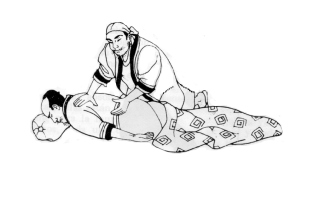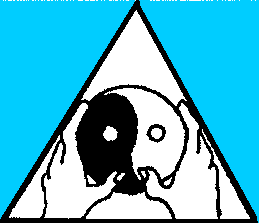

Shiatsu is Japanese for "finger pressure"; it is a type of alternative medicine consisting of finger and palm pressure, stretches, and other massage techniques. There is no scientific evidence for any medical efficacy of shiatsu, but some shiatsu practitioners promote it as a way to help people relax and cope with issues such as stress, muscle pain, nausea, anxiety, and depression. There are two main Shiatsu schools: one incorporating elements of evidence-based anatomy and physiology, and the other based on Traditional Chinese Medicine (TCM). Shiatsu is usually performed on a futon mat, with clients fully clothed. It is also performed on horses.
Shiatsu originated in Japan, following similar principles to chiropractic or western massage using the principles of anatomy and physiology. The thumbs, palms, and fingers (no knees or elbows are used in the foundation form of shiatsu therapy) are used to apply pressure to designated areas of the body.
All Shiatsupractors (Licensed Shiatsu practitioners) in Japan have to go through a government-regulated program which covers mostly the traditional form of Shiatsu Therapy.
This traditional form, now commonly practiced in North America, was started by Tokujiro Namikoshi, from whose lineage subsequent Shiatsu practitioners have been trained. Namikoshi developed his knowledge through trial and error, eventually gaining acceptance in the late 1950s.
His Shiatsu is described as "Diagnosis and Therapy combined", and relies on an understanding of how the body functions according to western principles of anatomy and physiology, as opposed to the principles in Traditional Chinese Medicine/TCM, although derivative forms of Shiatsu based on TCM (called Meridian Shiatsu) have been devised by later practitioners graduated from the Japan Shiatsu College established by Tokujiro Namikoshi in 1940.
Shiatsu, as well as Teate, originated in Japan. There were many hands-on therapies called Teate before traditional Chinese therapies such as Acupuncture and Tuina were introduced to Japan. Conflicting reports exist as to the date of the first use of the word Shiatsu.
However, there is no doubt that it was Tokujiro Namikoshi who founded the Japan Shiatsu College in 1940 and established and systematized Shiatsu Therapy. At the age of seven, Tokujiro Namikoshi developed a technique of pressing using his thumbs and palms as he tried to nurse his mother who suffered from Rheumatoid Arthritis.
He called the technique 'Pressure Therapy' at first but later renamed it 'Shiatsu Therapy'. He treated many high profile persons such as former Japanese Prime Minister Shigeru Yoshida and other successive Prime Ministers, the Prosecutor for the International Military Tribunal for the Far East, Prosecutor Keenan, as well as celebrities like Marilyn Monroe and Mohamed Ali.
In this way, Shiatsu became known not only in Japan but also overseas. The Japan Shiatsu College has produced many graduates who participate actively worldwide and who have devised their own Shiatsu styles.
These styles are derived from the original Shiatsu of Namikoshi and collectively termed Derivative Shiatsu. For example, Tadashi Izawa established Meridian Shiatsu, incorporating Meridian Theory of Traditional Chinese Medicine into his Shiatsu therapy. Shizuto Masunaga's book, called Zen Shiatsu in English, popularized Zen (or Masunaga) Shiatsu in North America and Europe.
Ryukyu Endo, a Buddhist priest, introduced Tao Shiatsu, which involves concentrating the mind and making supplications to the Buddha. Kiyoshi Ikenaga, in his book Tsubo Shiatsu, elucidates from an anatomical and physiological point of view, how meridian points (or Tsubo) are useful in Shiatsu Therapy.
The Japanese word 'Shiatsu' is known all around the world. In the English translation, this unique, originally Japanese, hands-on therapy is also called Shiatsu.
Published by Japanese medical department of the Ministry of Welfare (Current Ministry of Health, Labor and Welfare) in December 1957
The characteristic of Shiatsu is to practice using only the fingers, palms and especially the thumbs, but the essence of Shiatsu is Diagnosis and Therapy combined, which is the ability of the practitioner to use his sensory organs (palms, fingers and thumbs) to detect irregularities, such as stiffness of the surface of the body, and to promptly correct or heal these problems. To acquire this skill takes considerable experience.
The defining difference between Shiatsu therapy and modern and Kampo medicine (also known as Traditional Chinese Medicine, such as acupuncture and moxibustion) is this Diagnosis and Therapy combined; the fact that Shiatsu does not always require previous diagnosis before commencing treatment.
In modern medicine, the course of treatment can only be decided after a diagnosis has been made. In TCM, it is also necessary to diagnose before treating. In Shiatsu Therapy, practitioners promote the prevention and recovery of illnesses by stimulating the immune system and natural healing power that people already possess. Therefore, even without a diagnosis or with a language barrier, practitioners can, to quote Toru Namikoshi, treat patients with thumbs and thin futon at any time. Treating the body as a whole helps to restore the physical functions of the nervous system, circulatory system, bone structure, muscles, and internal secretion and stimulates its natural ability to heal illness. That being said, skilled practitioners can contribute considerably to regional health and medical treatment.
Shiatsupractor is the name given to the recently introduced international standardized Shiatsu license. This international standardization will not only ensure quality by setting guidelines for the practitioners of Shiatsu therapy, but also for the instructors, worldwide. In the past, in countries where Shiatsu has not been regulated by law, instructors often have not learned the medical basics, such as anatomy, physiology, pathology, which are require subjects in Japan, and those instructors often focus entirely on their knowledge of Kampo medicine.
The name Shiatsupractor was first used in British Columbia, Canada in 1990's has since been recognized by the International Shiatsu Association as the official name for the of the international standardized Shiatsu license. Presently, at the end of 2003, in the regions of North America (United States and Canada), Europe (member nations of the EU), and Japan, the use of Shiatsupractor is officially protected as a registered trademark.
In Japan, the educational standard for Shiatsupractor approval corresponds to that of the licenses for Anma, Massage and Shiatsu Practitioners. In other regions, if there are no regulations by public officials in the country or states, the requirements are two years and 2200 hours in North America and two-to-three years and 1600 hours in Europe.

The purpose Shiatsu is to bring the body into balance - the Yin/ Yang - which results in good health on all levels. In the 10th century, Japanese monks began to study Buddhism in China. They observed the healing methods of Traditional Chinese Medicine and took them back to Japan.
The word Shiatsu means ('Shi' means 'finger') - ('atsu' means 'pressure').
Shiatsu utilizes a combination of pressure and assisted-stretching tecniques. It is a combination of many different techniques, including pressing, hooking, sweeping, shaking, rotating, grasping, vibrating, patting, plucking, lifting, pinching, rolling, brushing, and, in one school developed by Suzuki Yamamoto, barefoot shiatsu, it includes walking on the person's back, legs, and feet.
Shiatsu can be done with the patient lying on a mat on the floor - or on a table. The patient remains fully clothed wearing loose fitting clothing. The atmosphere in the area should be calm - light music can be used if desired - soft lighting. Shiatsu